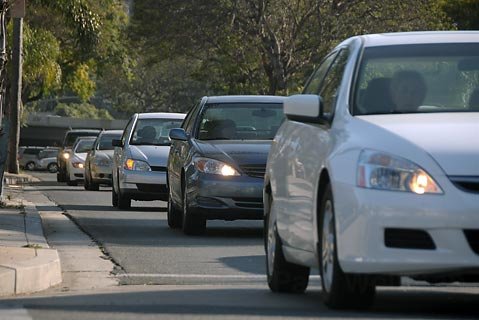Watching the Agendas: Week of September 14
Santa Barbara Proposes Air Pollution Increase; School Board Likely to Approve Budget Report

Santa Barbara County Association of Governments
This Tuesday, local government leaders are hosting the first of two public workshops to determine whether Santa Barbara County should try to reduce its greenhouse gas emissions by the years 2020 and 2030 to ensure there’s no net per capita increase. The workshops will also determine whether the public supports plans to allow Santa Barbara to actually increase such emissions by 6 and 4 percent respectively. On the table as well is a proposal to require an actual reduction in emissions. The state’s anti-global warming bill — SB 375 — requires that every government submit long-range plans regarding greenhouse gas emissions. Initially, Santa Barbara was one of only two counties statewide that proposed increasing its greenhouse gas emissions. The other was Monterey County, but recently, Monterey elected officials opted for a decrease. That leaves Santa Barbara as the only county to propose a net increase.
Public outcry by environmentalists that “the birth place of the environmental movement” would not do more prompted SBCAG — the Santa Barbara County Association of Governments — to slow down and hold two public workshops on the matter. The first is scheduled this Tuesday, September 14, at 5:30 p.m. in the Santa Maria county supervisors’ chambers. The next is September 18, also at 5:30 p.m., at the Santa Maria public library.

SBCAG staff members have defended their proposal, arguing that given demographic trends, Santa Barbara will rely increasingly on ever-increasing numbers of out-of-county workers to fill Santa Barbara jobs, especially in the southern half of the county. That’s because many South Coast employees are now reaching retirement age and show no interest in moving out of the area and selling their homes to a new generation of employees. Likewise, the high price of housing — even with the burst real estate bubble — will make home ownership on the South Coast unaffordable to all but the very wealthy or the very lucky. All this will necessitate a degree of commuting that will drive emission levels.
In addition, SBCAG officials argue that Santa Barbara has already reduced its per capita greenhouse gases sufficiently that, even with the increases projected for 2020 and 2030, Santa Barbara per capita levels will be much lower than big polluting counties that have already agreed to much stricter reductions. It’s not fair to penalize Santa Barbara, they say, for having done a good job.
Leading the charge to reduce levels by as much as 8 percent — or at least to maintain current levels — is the Community Environmental Council, which argues that the model deployed by SBCAG planners is faulty and that significant reductions can be realistically achieved. It contends that all counties must do their part to respond to an urgent environmental issue. Some South Coast representatives of the SBCAG board, like Santa Barbara Mayor Helene Schneider and 1st District Supervisor Salud Carbajal, have pushed for no new increases. But on the SBCAG board, North County votes outnumber those from the south, and North County representatives bristle vehemently at the prospect that the state could set any standards for Santa Barbara County. And the South Coast contingent is hardly unified either. Joe Armendariz, Carpinteria’s representative on the SBCAG board, regards the greenhouse gas bill as a jobs killer and has noted that the county’s air is quite clean. Barring two votes from North County representatives, it’s unclear that Santa Barbara’s proposed pollution increases will be changed.
The greenhouse gas bill has become a lightning rod in this November’s election, as the U.S. Chamber of Commerce and a number of oil companies have qualified an initiative for the ballot that would nullify the requirements of the greenhouse gas bill until unemployment drops below 5.5 percent. Statewide the unemployment rate is now around 12.5 percent. This week, Democratic candidate for Attorney General, Kamala Harris, spoke out against efforts to repeal SB 375. Her Republican opponent, Steve Cooley, has endorsed Prop. 23.
Santa Barbara School District’s Board of Education
Tuesday night’s Santa Barbara School Board meeting will feature a discussion and, most likely, approval of the final 2009/10 budget fiscal report. With the books officially closed on last year’s fiscal calendar, board members will get some good news about where it ended up — with an unaudited ending balance of some $8.6 million on their unrestricted side of the ledger. The number is about $1.3 million more than what they had thought they would have in the bank after the 2009/10 school year. Despite this minor fiscal victory, the board must produce, at the behest of the Santa Barbara County Education office, an approved plan for budget reductions in their 2010/11 budget no later than December 15. Never an easy process, that whittling cannot take place until they officially close the door on last year’s numbers.
Also at the board, members will discuss — and most likely approve — the spending of funds generated by voter-approved Measures H and I. Dealing with property tax measures specifically designed to help subsidize math, science, music, and theater offerings in grades K-12, the board will be voting on specific site plans for spending of said money at all district facilities save for La Cuesta Continuation High School, Cleveland and Franklin Elementary schools, and San Marcos and Santa Barbara High schools. The aforementioned schools will have their site plans decided upon later this year after the Measure H and I Oversight Committee has ample time to flesh them out.
A final item of intrigue at the board will be a presentation by Dr. Davis Hayden, the district’s research and evaluation guru, on just how Santa Barbara schools did last year in regard to No Child Left Behind standards and California’s Academic Performance Index.


